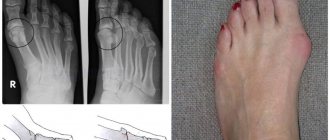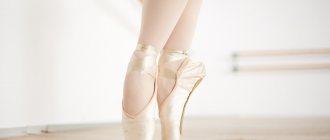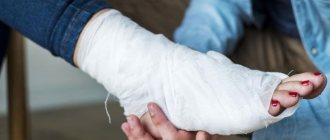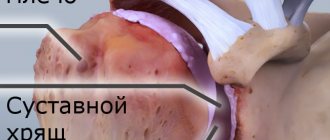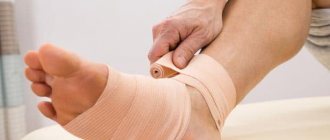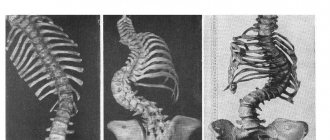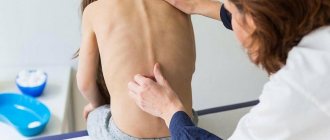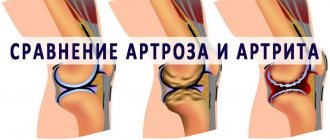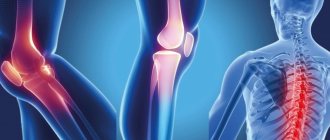Arthrosis of the ankle joint or arthrosis of the tibiotalar joint is a fairly common pathology, although inferior in frequency to arthrosis of the knee and hip joints. The most common cause is previous trauma (in 60% of cases), another 10% is due to idiopathic arthrosis, the remaining 30% is divided between rheumatic diseases, osteonecrosis, septic arthritis, gout, etc.
Ankle fractures, one of the most common skeletal fractures, often result in a disruption of the relationship of the bones in the ankle joint. Changes in joint geometry and load distribution lead to rapid wear of cartilage, narrowing of the joint space, subchondral sclerosis and the growth of osteophytes. If untimely and inadequately treated, ankle fractures can lead to the formation of arthrosis of the ankle joint for several years after the injury.
| Stage 1 | Subchondral sclerosis and the onset of osteophyte growth | |
| Stage 2 | Narrowing of the joint space in the medial region | |
| Stage 3A | Further narrowing of the joint space in the medial part of the joint until the contact of the subchondral bone | |
| Stage 3B | Narrowing of the joint space in the area of the roof of the dome of the talus to the contact of the subchondral bone | |
| Stage 4 | Complete obliteration of the joint |
-Pain with axial load (walking, running)
-Decreased range of motion (normally 20° dorsiflexion and 50° plantar flexion
flexion)
-Swelling in the ankle area
-Pain when checking range of motion during physical examination
-There may be visible deformation
For diagnosis, radiographs are taken in direct, lateral and oblique projections, with a load of body weight. X-rays reveal narrowing of the joint space, subchondral sclerosis, formation of cysts, deformation, and growth of osteophytes.
Conservative measures include reducing physical activity, using orthoses and braces, and non-steroidal anti-inflammatory drugs.
The use of orthopedic shoes with ankle relief can completely relieve pain in almost half of the cases.
If conservative measures are ineffective, surgical treatment is indicated.
Arthrosis of the ankle - what is it?
Osteoarthritis of the ankle joint
is a disease whose progress is accompanied by the destruction of the cartilage tissue of the joint of the lower extremities, as well as the adjacent bones.
It is also worth noting that osteoarthritis of the ankle joint is characterized by a chronic nature and undulating course (systematic periods of exacerbations followed by remissions).
The disease is characteristic mainly of people of the older generation, but recently it is increasingly occurring in a situation where arthrosis is diagnosed in people under 45 years of age. According to statistical data, destruction of the cartilage tissue of the ankle is detected in 6% of applicants.
Timely diagnosis and a well-defined treatment plan for ankle arthrosis can completely cure the disease.
Cost of treatment of deforming arthrosis
The prices indicated in the price list may differ from the actual prices. Please check the current cost by calling +7 495 104 8605 (24 hours a day) or at the GMS Hospital clinic at the address: Moscow, st. Kalanchevskaya, 45.
| Name | Price |
| Initial consultation with a leading surgeon/traumatologist/orthopedist | RUB 9,566 |
| Initial appointment with a surgeon/traumatologist/orthopedist | RUR 6,696 |
| Repeated consultation with leading surgeon/traumatologist/orthopedist | RUB 8,131 |
| Repeated appointment with a surgeon/traumatologist/orthopedist | RUB 5,691 |
Dear Clients! Each case is individual and the final cost of your treatment can only be found out after an in-person visit to a GMS Hospital doctor. Prices for the most popular services are indicated with a 30% discount, which is valid when paying in cash or by credit card. You can be served under a VHI policy, pay separately for each visit, sign an agreement for an annual medical program, or make a deposit and receive services at a discount. On weekends and holidays, the clinic reserves the right to charge additional payments according to the current price list. Services are provided on the basis of a concluded contract.
Plastic cards MasterCard, VISA, Maestro, MIR are accepted for payment. Contactless payment with Apple Pay, Google Pay and Android Pay cards is also available.
Western standards of treatment (evidence-based medicine)
Continuous staff development
Regular interaction with leading Russian and foreign medical institutions
Modern medical equipment and advanced diagnostic and treatment methods
Unified standard of service
We work around the clock 24/7/365
Make an appointment We will be happy to answer any questions Coordinator Oksana
Main causes and principles of progression of ankle osteoarthritis
Arthrosis of the ankle joint is a special disease that can be a primary phenomenon, or it can be secondary, in which the disease progresses after injury or inflammation.
Regardless of the type, arthrosis occurs mainly in conditions of disruption of the natural processes occurring inside the articular cartilage.
Considering the key factors in the development of the disease, it is worth highlighting:
- microtraumas, as well as major injuries to the ankle joint;
- excess body weight;
- performing surgery on a joint;
- improperly selected shoes, abuse of high heels;
- excessive physical activity;
- metabolic disorders caused by various diseases (gout, hormonal imbalance);
- diseases of the musculoskeletal system;
- genetic predisposition;
- bad ecology.
Under conditions of normal metabolic processes, the superficial articular tissues are characterized by smoothness and elasticity, ensuring unhindered gliding during movement.
When a joint is injured or metabolic processes are disrupted, the smoothness and elasticity of the tissues is lost, which causes friction and significantly aggravates the consequences.
Why is it developing?
Just imagine: the ankle joint can withstand a load that is 6-7 times the human body weight. The reason for this is the complex anatomical structure, as well as the characteristic plexus of ligaments, muscles and fascia. It is not surprising that microtraumas occur in this area of the musculoskeletal system more often than others.
People at risk for developing ankle arthrosis:
- overweight;
- with metabolic disorders;
- after injury or inflammation of cartilage tissue.
Excess weight is an additional load on the ankle: the risk of developing arthrosis increases
What is deforming arthrosis of the ankle and what are the reasons for its development? What traditional and folk methods of treatment are used today?
Types and degrees of ankle osteoarthritis
Today, it is customary to distinguish two types of arthrosis localized in the ankle joint:
- primary
– the development of pathological processes directly on healthy cartilage tissues; - secondary (post-traumatic)
– degenerative processes that occur during the development of various types of diseases/injuries.
In addition, modern medicine also distinguishes several degrees of degenerative disease:
Arthrosis of the ankle joint 1st degree
– the first stage of the development of the disease, accompanied by a clear manifestation of symptoms. Patients complain mainly of symptoms such as:
- increased fatigue;
- leg pain.
During diagnostic procedures, pathological processes are practically invisible, which complicates the process of identifying the disease.
Arthrosis of the ankle joint 2 degrees
– manifests itself in severe pain that disrupts the healthy sleep of patients.
Visual signs of the disease appear. Inflammation of the joint becomes visually noticeable: a local change in the color of the skin (redness) occurs, as well as an increase in its temperature. In addition, swelling begins, movements are limited.
Arthrosis of the ankle joint 3rd degree
– accompanied by pronounced discomfort and severe aching pain, which is a sign of the beginning of the transformation of cartilage into bone tissue.
Joint mobility is limited or completely lost. Joint movements occur with a crunch.
The lack of necessary treatment for arthrosis of the ankle joint in the later stages of the disease inevitably leads to loss of ability to work and obtaining the “disabled” status.
When should you sound the alarm?
At the initial stage, ankle arthrosis, as a rule, does not make itself felt, and yet there are indirect signs that cannot be ignored:
- fatigue in the legs that was not there before;
- unusual fatigue;
- minor pain, especially after intense physical activity.
Among athletes, who constitute the main risk group for arthrosis, they often do not pay attention to mild pain and minor limitation of movement. Meanwhile, it is these symptoms that indicate the onset of degenerative-dystrophic changes in the ankle joints. At this stage, drugs that improve metabolism are sufficient to treat deforming arthrosis of the ankle joint. If the moment is missed, the therapy will be much more serious.
It is not difficult for an orthopedic doctor to diagnose arthrosis even at the initial stage
Symptoms of ankle arthrosis
Before understanding how and how to treat osteoarthritis of the ankle joint, it is important to identify its symptoms.
Considering the clinical picture of the disease, one can notice that the key symptoms of arthrosis localized in the ankle joint are increased fatigue and severe pain. As the disease develops, the situation worsens, which leads to increased pain that does not go away even during periods of rest and long sleep.
Over time, the motor activity of the affected joint is significantly limited, and a fairly severe deformation of the ankle is visually visible. However, in addition to this, symptoms of ankle arthrosis include:
- an increase in pain even with minor exertion;
- discoloration of the skin and swelling of the tissues of the affected joint;
- swelling of the foot;
- characteristic crunch when moving the joint;
- loss of the ability to freely move the ankle;
- local increase in temperature indicators.
The presence of just a few or even one symptom of ankle arthrosis should be the reason for urgently seeking qualified medical help.
Deforming osteoarthritis of the ankle joint: how does it appear?
The ankle joint does not have its own vascular system, therefore, with metabolic disruptions caused by aging, intense training or other factors, the nutrition of the cartilage tissue is also disrupted. Due to the lack of “building materials” and important microelements, intracellular metabolism decreases, cartilage recovers poorly and slowly, and its basic structure gradually changes.
Chondroitin and glucosamine are synthesized less frequently and in small volumes, which are not enough to support and timely restore the joint. Hence the loss of elasticity, shock-absorbing properties and strength, and the formation of bone growths. In the future, if the disease starts and you don’t know how to treat osteochondrosis of the ankle joint, the cartilage will continue to deteriorate.
In the initial stages of the disease, symptoms of osteoarthritis of the ankle joint are rarely bothersome. Sometimes there is pain, but it goes away as quickly as it started.
Factors that can provoke OGS:
- Poor nutrition.
The body lacks protein, fatty acids and other essential substances.
- Uncomfortable shoes.
For example, high heels.
- Heredity.
- Age-related changes.
- Increased sports loads.
For example, boxing or dancing. There is also a high risk of arthrosis if you suddenly stop playing sports.
- Excess weight.
Excess weight significantly increases pressure on the joints.
- Flat feet, high stature, congenital dysplasia.
- Concomitant diseases such as diabetes, hemophilia, osteochondral disorders or vascular atherosclerosis.
It may occur due to problems with hormones or the thyroid gland. Especially at risk for women during menopause.
- Inactivity.
A lack of daily physical activity weakens muscles, which significantly increases the load on joints.
- What else potentially influences the development of ankle osteoarthritis?
- Hypothermia of the legs.
For example, your feet are cold because your shoes are not appropriate for the season.
- Carrying heavy things.
Arthrosis is especially often diagnosed among loaders.
- Injuries in the ankle area.
Any dislocations and fractures can cause cracks in the cartilage tissue. If microtrauma is not noticed and treated in time, serious consequences and diagnoses cannot be avoided.
In addition, the prerequisites include different leg lengths (due to shifting loads), damage to internal organs, and deformation of the toes. Work that requires a person to stand for a long time throughout the working day also often becomes an aggravating factor along with obesity.
Which doctor should I contact and how to treat arthrosis of the ankle joint?
Doctors such as an orthopedic traumatologist and a rheumatologist treat osteoarthritis of the ankle. If you suspect the presence of a disease, you should refrain from self-medication. Ignoring symptomatic manifestations can aggravate degenerative processes and lead to extremely negative consequences.
Arthrosis of the ankle joint grades 1 and 2 can be successfully treated. For this reason, when the first signs appear, it is important to contact your local physician, who will refer you to a specialist for diagnosis.
Despite the complexity of the situation, grade 3 ankle arthrosis is also treatable, but mostly radical measures are used.
Today, various methods are used to treat ankle arthrosis, including non-drug therapy and medication.
Let's look at the available methods in more detail.
Physiotherapy for ankle osteoarthritis
Physiotherapy
is a unique area of modern medicine that uses natural as well as artificially created physical capabilities for the prevention and treatment of various diseases.
The use of physiotherapy as a treatment for ankle osteoarthritis makes it possible to significantly reduce the amount or completely eliminate the use of medications.
Physiotherapy methods help to significantly improve blood circulation in the affected joint, which ensures activation and acceleration of the recovery processes occurring inside the ankle.
In the treatment of ankle osteoarthritis the following are used:
- laser irradiation;
- ultrasonic influence;
- electrical stimulation.
Treatment of ankle arthrosis is determined in accordance with the symptoms that appear and the intensity of the disease.
Massage and ankle arthrosis
Massage
is a complex of mechanical and reflex techniques, the use of which ensures increased blood circulation, which significantly accelerates the restoration of affected tissues.
Treatment of ankle osteoarthritis with massage, in addition to reducing the rate of progression of the disease, helps prevent the likelihood of its exacerbation.
Only a specialist who knows the structural features of the joints can perform a massage to treat arthrosis of the ankle joint. It is important to note that the duration of the massage should be at least 25 minutes.
Using massage in tandem with exercises for arthrosis of the ankle joint will ensure the achievement of the most effective results in a relatively short time.
Exercises and exercise therapy for ankle arthrosis
Despite the fact that many are of the opinion that physical therapy (physical therapy) for arthrosis is ineffective, physical activity is the key to getting rid of hated pain and significantly improving well-being.
Correctly selected exercises for arthrosis of the ankle joint lead to:
- eradication of the feeling of stiffness when walking;
- activation of blood circulation in the internal tissues of the joint;
- slowing down, and in some cases even completely stopping the course of the disease;
- restoration, improving quality of life.
It is important to note that for osteoarthritis of the ankle joint, exercises are selected exclusively in accordance with the recommendations of the attending physician.
Surgical intervention for osteoarthritis of the ankle joint
In a situation where conservative treatment of ankle osteoarthritis does not produce the desired results, a more radical method of eliminating the disease comes to the rescue - surgery.
Today, the following types of surgical intervention are possible:
- endoprosthetics
– complete replacement of the ankle joint; - arthroscopy
– elimination of excessive formations inside the ankle; - arthrodesis
– immobilization of the ankle while preserving remnants of cartilage.
Surgery falls into the category of last resort methods for treating ankle arthrosis. Timely diagnosis and a well-structured treatment plan can prevent the need for radical measures.
In order to consolidate the postoperative result and speed up the recovery of the joint, specialists prescribe a set of exercises for osteoarthritis of the ankle joint.
Is there an alternative to surgery?
In difficult cases, when conservative treatment of arthrosis of the foot has not helped and there is no mobility, surgery is indicated. Like any surgical intervention, endoprosthetics (replacing a joint with an implant) has contraindications and carries certain risks. Today, fortunately, this is not the only way to restore joint health - this can be done at the second or third stage of the disease, with the help of a synovial fluid endoprosthesis.
For example, the biopolymer with silver ions “Noltrex” is intended for intra-articular administration in a sterile dressing room. Its task is to restore the viscosity of the synovial fluid in the affected ankle joint. The drug reduces friction in the joint, which relieves pain and improves mobility. However, Noltrex does not affect the metabolism of cartilage. A feature of the Noltrex endoprosthesis is its very slow biodegradation, which explains its long-term effect (at least six months).
The synovial fluid endoprosthesis is inserted under local anesthesia in a dressing room or operating room. Here's how it works in the case of the ankle joint:
After inserting a synovial fluid implant, it will not be superfluous to prevent complications. Orthopedic doctors recommend that physical activity be dosed correctly, monitor nutrition and body weight, and that athletes respond to injuries and microtraumas in a timely manner. Movement is life, and ankle health is the key to an active lifestyle!
Treatment of ankle arthrosis with drugs
Drug treatment of ankle arthrosis is part of complex therapy, providing the opportunity to relieve unpleasant symptoms and stop degenerative changes.
How to treat arthrosis of the ankle joint can only be determined by a specialist who knows the characteristics of the disease being diagnosed. Self-medication with medications can cause irreparable harm to the body.
All drugs for the treatment of osteoarthritis of the ankle joint are divided into several groups, each of which differs not only in the principles of action, but also in the degree of effectiveness.
Let's look at some of them in more detail.
Anti-inflammatory and painkillers
Nonsteroidal anti-inflammatory drugs for the treatment of osteoarthritis of the ankle joint are used at various stages of the development of the disease.
The key focus of this type of action is to relieve pain and relieve inflammation in the joint.
Today, the medicine market offers anti-inflammatory and painkillers not only in the form of gels and ointments, but also in the form of tablets, patches and injections, the most effective of which are considered to be “Artradol”, “Ketoprofen”, “Structum” and “Aceclofecan” .
Antispasmodics-muscle relaxants
Drugs for the treatment of osteoarthritis of the ankle joint, such as antispasmodics and muscle relaxants, are prescribed as an active aid in the fight against spasms of the muscles adjacent to the affected joints.
Antispasmodics provide muscle relaxation and pain relief. Mydocalm is considered to be the most relevant drug today.
Chondroprotectors
Chondroprotector
is a drug for the treatment of osteoarthritis of the ankle joint, providing stimulation of the production of a sufficient amount of intra-articular fluid, which ensures accelerated tissue regeneration and saturation with essential vitamins and minerals.
The most effective effect is provided by the drug "Artracam", which has proven itself in the market of modern medicines.
Basics of conservative treatment
First of all, it is important to eliminate the provoking factors, otherwise the treatment will not be effective. For some it’s excess weight, for others it’s high heels or standing for long periods of time. It will never be a bad idea to switch from flour, salted and smoked foods to fiber, fresh fruits and fermented milk products in order to stabilize the metabolism.
After such recommendations, the patient is prescribed medication according to indications:
- non-steroidal anti-inflammatory drugs and painkillers (tablets, ointments, injections);
- chondroprotectors containing glucosamine sulfate and chondroitin sulfate to give the cartilage layer density and elasticity (taken for a long time - more than six months).
Complex treatment may include:
- physiotherapy (regular procedures stop destruction in the joints);
- therapeutic massage - to strengthen the muscles of the foot and lower leg, as well as improve blood circulation;
- wearing orthopedic shoes that reduce the load on the joint;
- hiking and swimming;
- sanatorium-resort treatment in specialized health resorts.
Best way to restore ankle mobility - swimming and walking
Possible complications
In the absence of comprehensive treatment for ankle arthrosis, the likelihood of complete recovery is reduced to almost zero.
Self-treatment and ignoring the symptoms of the disease inevitably lead to limb immobilization and disability.
In the presence of symptoms and insufficient treatment of arthrosis of the ankle joint, the progress of destructive processes causes the occurrence of osteophytes (growths on bone tissue), which negatively affects a person’s quality of life.
Constant swelling of the tissues of the affected joint can also cause the development of pathological processes in the blood vessels, in particular, deterioration of blood circulation, impaired blood flow.
Long-term destructive processes developing in the joint lead to immobilization of the ankle, which increases the risk of concomitant diseases and injuries.
Therapeutic methods
Treatment of ankle DOA is mainly based on drug and non-drug therapy. Only in rare cases, a severe form of the disease is eliminated surgically.
Treatment of deforming arthrosis of the ankle has three main therapeutic objectives:
- Tactical selection of medications that help eliminate pain symptoms, improve the functional state of the osteoarticular system using various non-steroidal anti-inflammatory groups, analgesics, and local anesthetic drugs.
- A further strategic goal is to prevent the degenerative decay of the articular surface and restore damaged tissues with the help of biogenic stimulants, chondroprotectors and quinoline alkaloids.
- The recovery and rehabilitation period is a program of physiotherapeutic procedures, gymnastic exercises, therapeutic massage and the use of traditional medicine.
The starting phase, or grade 1 deforming arthrosis of the ankle joint, does not require serious medical intervention. At this stage of the disease, preventive treatment measures are sufficient.
The use of analgesic, anti-inflammatory and painkillers is very effective.
| Drug name | pharmachologic effect |
| Artra® msm forte (tab.) | The composition helps to inhibit the progression of osteoarthritis, suppress the destruction and regenerative stimulation of cartilage tissue. The drug has an analgesic and anti-inflammatory effect, improves blood circulation in the subchondral bone, reduces the need for non-steroidal stimulation |
| Alflutop® (injection solution) | The active component of the pharmacological agent is a bioactive concentrate from small sea fish containing amino acids, mucopolysaccharides and mineral groups. The drug prevents the destruction of tissue macrostructures, stimulates the restoration of interstitial tissue, tissue of the articular cartilaginous surface |
| Chondroxide® maximum (cream for external application) | The main active component, glucosamine sulfate, promotes the restoration of peripheral areas of the articular surface, inhibits the formation of superoxide radicals and enzyme formations, leading to the destruction of the tissue base of the joint. |
| Teraflex® m (cream for external use) | The medicinal composition of the drug improves the regeneration of cartilage tissue and has an anti-inflammatory effect. Teraflex® m has an antiseptic and moderate anesthetic effect |
Medicines containing nicotinic acid and vitamins D and B will help improve blood circulation in the joints. In the initial phase of deforming arthrosis, the use of physiotherapy, laser therapy, and therapeutic massage will be effective.
Deforming arthrosis of the 2nd degree of the ankle joint requires more intensive drug therapy.
Non-steroidal anti-inflammatory combinations come to the rescue, for example:
- drug for intramuscular administration – Amelotex ®. A non-steroidal anti-inflammatory drug with an antipyretic effect, counteracts enzymatic activity, and helps improve blood flow regulation. The drug is not recommended to be taken during pregnancy and breastfeeding;
- prescription drug Airtal ® with the active ingredient aceclofenac, has an analgesic and anti-inflammatory effect. The active substance is very effective in the treatment of deforming arthrosis of the ankle joint of the 2nd degree, when swelling of the joints occurs with severe pain, the activity of the musculoskeletal and articular segments of the supporting apparatus is limited;
- Ibuprofen ®, a dosage form of non-steroidal anti-inflammatory activity, will help reduce pain in the ankle joints Helps actively reduce pain sensitivity at the site of inflammation, reduces morning stiffness in the joints, and has a beneficial effect on increasing the range of motion of the osteoarticular components of the ankle.
The listed treatments are provided for informational purposes. Any self-medication may have adverse consequences. Only a doctor determines the severity of the disease and prescribes the necessary treatment.
Basic principles of dietary nutrition for ankle arthrosis
According to numerous studies, it has been noted that arthrosis mainly occurs in people who do not follow their diet.
Following a diet and taking into account certain nutritional principles speeds up the treatment of many diseases, in particular arthrosis.
The key principle of nutrition for arthrosis is balance. In addition, criteria such as:
- regularity of meals;
- variety of food products;
- correspondence between nutritional value and intensity of energy expenditure.
During the period of treatment and rehabilitation, the patient's diet should consist mainly of dishes prepared using gelatin. In addition, it is important to give preference to foods enriched with vitamins of various groups and other beneficial microelements.
To speed up your recovery, it is also recommended to avoid drinking sugary carbonated drinks and alcohol.
Types of arthrosis development
For treatment of arthrosis of the foot joints to be successful, it is necessary to make a correct diagnosis. Each stage of disease development requires a different set of therapeutic measures. Doctors distinguish the following stages of pathology development:
- First. At this stage, noticeable fatigue of the lower extremities appears, as well as “pulling” pain after long walks or excessive physical exertion. At this stage, the patient may not even suspect that he is developing a disease, because he attributes the symptoms to banal fatigue. But if you do not visit a doctor, the disease will begin to gain momentum;
- Second. All the symptoms of the first stage begin to appear more actively. The pain becomes longer and more severe. Calluses may appear on the heels due to improper foot position, the knuckles become thicker;
- Third. The joints undergo serious changes, so the person begins to limp severely. Joint mobility decreases. X-rays show that the gaps between the joints are significantly reduced or disappear completely.
To make a diagnosis, the doctor must conduct an examination and diagnosis. It includes:
- taking an anamnesis, when the doctor asks the patient about all his complaints;
- X-rays and other examinations that will make it possible to accurately determine the condition of the joints, cartilage and bones, and also identify possible changes in their structure;
- examinations that will allow you to study the condition of muscle tissue;
- tests to find out about the state of the body and the nature of inflammation in it;
- measuring the size of the foot so that you can track the dynamics of treatment for arthrosis of the toe or any other joint.
Prevention of ankle osteoarthritis
The best treatment for ankle osteoarthritis is prevention
.
To minimize or completely eliminate the likelihood of degenerative-dystrophic processes in the ankle, experts around the world recommend adhering to the simplest principles:
- constant monitoring of diet;
- tracking and control of optimal body weight;
- caution and avoidance of injuries to the lower extremities;
- allocating enough time for a good warm-up before physical activity;
- timely treatment of inflammatory diseases;
- maintaining an optimal balance of microelements in the body.
Compliance with the simplest preventive recommendations will eliminate the likelihood of symptoms of ankle arthrosis and limit the need to treat ailments of this kind.
Remember, consulting a doctor when observing the initial symptoms of osteoarthritis of the ankle joint guarantees its timely diagnosis and high-quality, successful treatment.
Joint gymnastics and traditional medicine
For grades 1 and 2 of deforming osteoarthritis, it is useful to use therapeutic prophylaxis. As an alternative home therapy, in addition to the main course prescribed by your attending physician, you can continue treatment of deforming arthrosis of the ankle joint with folk remedies and perform simple exercises for the ankle joint.
Joint gymnastics for the ankle:
- walking on high toes. Knees straight, feet on toes. We alternately raise the straightened feet parallel to the floor surface, the second leg stands on the toes. The exercise is repeated 8 times;
- walking on your heels. We shorten the leg as much as possible without lowering the foot down. Do the exercise 8 times;
- walking on the back of the foot 8 times, a similar exercise on the inner foot;
- rolling from toe to heel and back. Feet are on your toes and slightly bent at the knees. Alternatingly lowering ourselves onto our heels with both legs, we return to the starting position. The gymnastic approach is repeated 8 times;
- starting position sitting cross-legged. Using the force of our hands, we spring our knees to the sides. Repeat 8 times;
- starting position sitting. The feet are connected, and the center of gravity is transferred to the heels. Leaning on your hands, we perform spring movements with your knees to the sides. We repeat the exercise 8 times;
- sitting on the floor, legs straightened at the knees. We stretch the foot forward and backward as much as possible, repeating each movement 8 times.
In case of pain, the set of gymnastic exercises should be stopped immediately.
Treatment of DOA of the ankle joint with traditional methods is a preventive measure that helps relieve pain symptoms, but does not eliminate the cause of the condition.
Popular traditional medicine recipes for osteoarthritis of the ankle joint:
- A glass of dry sunflower root is poured into 3 liters of water, boiled for no more than 5-7 minutes. The medicine is used for 3 days, dividing the healing mixture into equal parts. This treatment ensures that the body quickly flushes out salt. The course of treatment is determined by the consulting specialist;
- A glass of a mixture of dry calendula, birch leaves and nettle in equal parts is brewed in 250 ml of boiling water. The prepared mixture is applied to the sore joint. Covered with cellophane film and warm woolen cloth. You need to keep this compress for at least 2-2.5 hours. Thanks to this composition, blood circulation improves, which has a beneficial effect on the functional functioning of the articular surfaces. The course of treatment is prescribed by a doctor;
- horse chestnut fruits (10 pcs.) are crushed, poured with 0.5 liters of vodka or diluted alcohol. The healing agent is infused for three weeks. Apply externally, rubbing the mixture into sore joints. For internal use, 1 teaspoon three times a day is enough. The course of treatment is determined by the doctor;
- 10 grams of dry bay leaf are poured with water and boiled for 5-7 minutes. The decoction is recommended for internal use 3 times a day. Duration of treatment is 2-3 weeks.
A compress of grated raw potatoes, white cabbage leaves, a mixture of crushed chalk (50 g) and homemade curdled milk (100 ml) will help relieve swelling of the joints and reduce pain. It is advisable to apply such compresses before bedtime.
You can eliminate unpleasant pain symptoms with a compress of sea salt or a mixture of apple cider vinegar (50 g), turpentine (50 ml) and egg yolk. Any alternative treatment must be approved by a doctor and not cause an allergic reaction. Contraindications to traditional medicine are chronic diseases of the gastrointestinal tract, renal and/or liver failure.
